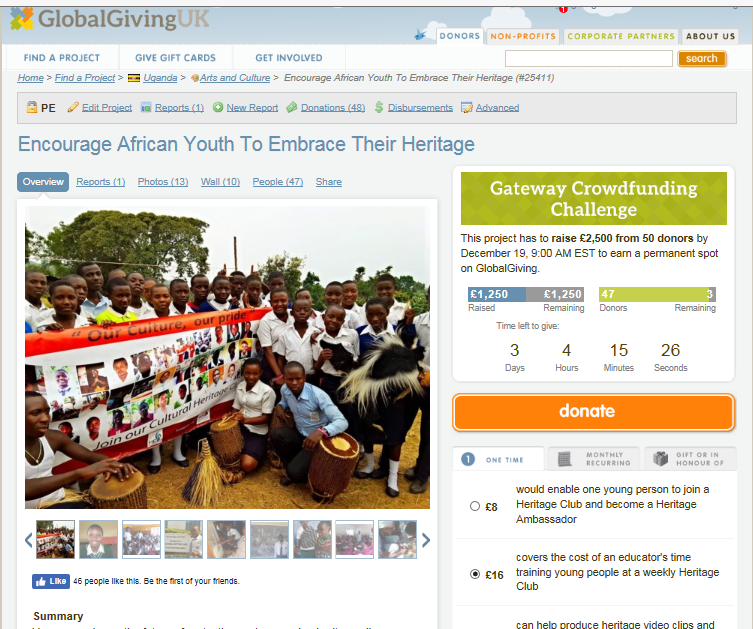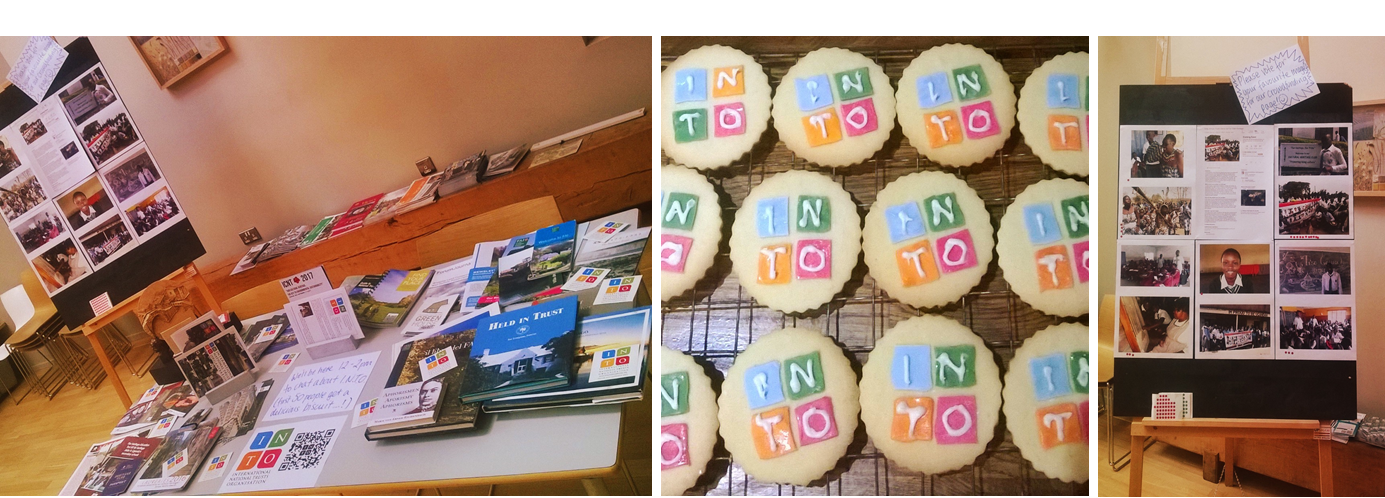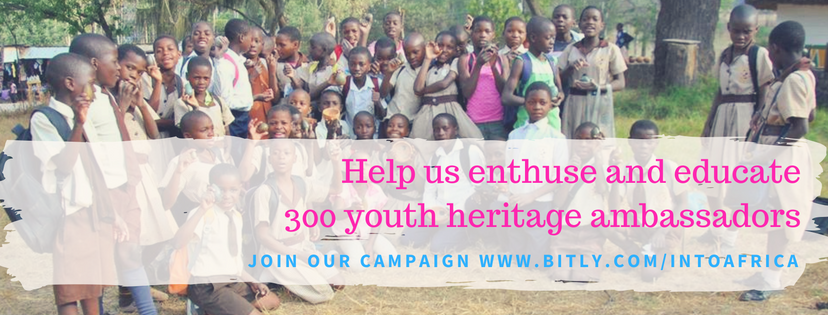-
GlobalGiving crowdfunding experience (Weekly blog, 5 February 2017)
Posted on February 5, 2017A blog by Catherine Leonard, Secretary-General
 You will have not been able to miss our GlobalGiving campaign at the end of last year – many thanks for following the story, sharing and donating! Here is some feedback on the experience from my perspective, which I hope you will find useful.
You will have not been able to miss our GlobalGiving campaign at the end of last year – many thanks for following the story, sharing and donating! Here is some feedback on the experience from my perspective, which I hope you will find useful.What is GlobalGiving?
We applied to join the GlobalGiving Winter 2016 Gateway to Crowdfunding Challenge just days before the deadline and immediately started on an amazing, thrilling and unstoppable crowdfunding rollercoaster!
Firstly, GlobalGiving provides a platform alongside an excellent training programme and general handholding for charities starting their crowdfunding journey. Within days, the webinars started (see links below) and we were off! A small gang of hopefuls embracing the challenge of raising over £2,500 from more than 50 donors in just five weeks.
Success would mean not only raising funds for our project but also becoming partners of GlobalGiving and enjoying access to additional funds, skilled volunteering and corporate partners. (Spoiler alert: We made it! So can now run further campaigns with our INTO partners – let us know if you’re interested in exploring the idea!)
Encouraging African Youth to Embrace their Heritage
Following an introduction to GlobalGiving and the process, the second session was about creating a project page. Well, we didn’t even have a project at that stage so we were already up against it timewise. Nothing like a deadline to focus the mind! Fortunately, that very week Isatu Smith of the Sierra Leone Monuments and Relics Commission had come into the INTO office. Partly inspired by that meeting, we decided to focus our pilot crowd fundraising efforts on the emerging heritage education project being planned by the Cross-Cultural Foundation of Uganda, the National Trust of Zimbabwe and Isatu’s organisation.
Our job was to turn their project note into a clear and concise appeal. With photos and videos. In two weeks! (There is a bit more about this in my blog of 16 October.)
Meeting the team
Noémie and I attended a workshop at the GlobalGiving offices in London in the second week of training, which really helped crystalise things – and meant we could meet some of the other folks involved in the challenge. It was interesting to hear about their organisations and projects although it also made us realise that it was a competition, which felt a bit daunting. (Cash prizes were awarded for the projects raising the most money and/or with the most individual donors.)

Effectiveness and engagement rewards
To encourage us along, GlobalGiving uses a system that recognizes and rewards its partners for their efforts to learn, improve, and grow their impact. Thus engagement is rewarded, which in turn gives you access to increased benefits from GlobalGiving. (I’ve even been thinking about how we could embrace this system. Maybe INTO members could get points for attending webinars, sharing learning, responding to surveys and requests …!?) At the time of writing, INTO has in fact earned 79 GG Rewards making us a GlobalGiving Superstar! Moreover, our project is currently ranked 205 out of 21,943. Wow!
No crowd – no funding
The session on network mapping was particularly illuminating. I think we had been under the (mistaken) impression that crowdfunding was simply about putting something on the internet, sitting back and watching the funds come rolling in. Far from it! Looking at who is in – or could be in – your crowd is a really vital part of crowdfunding. No crowd – no funding.
In many ways, INTO was off to a good start. We are already a network with 73 member organisations that share our mission, trust us and are personally connected to us. We also have a loyal band of Amicus supporters, newsletter subscribers, social media followers and past ICNT delegates.
Furthermore the webinar highlighted the importance of each of us mapping our personal networks and valuing our connections. Alongside providing content for them to share with their contacts, in different formats.
The last two sessions focussed on electronic communications. I found these two webinars particularly interesting and helpful, in ways beyond the GlobalGiving challenge.

Using email effectively
Firstly, email is considered more likely to result in a donation than social media. Secondly, the best are personal communications to friends and networks. Effective emails therefore have:
• Good subject headings which arouse curiosity
• Tell a compelling story
• A call to action
• Big and beautiful images
• Make it easy to giveMost important of all, they need to sent often/repeatedly in order to get a response …
Social media
Social media needs to be:
• Planned in advance
• A sustained execution
• Followed upPosts should be authentic and personal; creative and imaginative. Moreover, they need goals (!Wow! Who knew?!). They should always link back to the project page (using a customised bitly link). Pictures are essential. Inspirational quotes from beneficiaries, staff and famous people also work well. So do cats … And statistics, infographics and questions. Short ones are probably the best (<80 characters).

GlobalGiving recommend daily facebook posts and 5 tweets a day during the campaign! Also a day-by-day schedule of social media/email activity.
Lessons learned …
-
It’s not all about the money
Embarking on a crowdfunding campaign is not for the fainthearted. It involves huge amounts of planning and sustained execution. It is undeniably all-consuming and exhausting. But the rewards – engagement of donors, getting your message out and (of course, although lower down the list than you might have first imagined) raising vital funds for important projects – can be great. Raising $3,447 for a heritage education project in Africa has been brilliant and we couldn’t have done it without your support. (Thank you, once again!)
But we’ve also all learned so much throughout the process. And not just about crowdfunding. Amongst other things, I’ve discovered the online design programme Canva and made my first ever clips with Movie Maker, in addition to all the useful advice about planning, social media and emails.

-
You can’t do it on your own:
It’s so important to have a team of energetic people working together on the campaign. Not only will this keep you sane (!) but you need other people to help you build your crowd. Board members and volunteers must be fully on board with the project. And they should each map their own networks.
-
Plan, plan, plan:
In order to succeed, you need to start with a specific project, timescale and goal. Then you need a plan – for the project and the campaign. GlobalGiving recommend a daily plan for the whole campaign: Schedule fundraising events and pre-launch activities; anticipate a lull in giving in the third week; prepare your social media; plan, plan, plan!
Because time was tight, and we also already knew we could fundraise from events, we decided not to include these in our plan/campaign, which was perhaps an error of judgement. They would have generated more noise and engagement – as well as funds. Interestingly projects that raise 30% of their target in the first week are most likely to succeed. We’ll definitely be including more off-line events in our next campaign!
-
Use great content:
Finding the right words to describe your project is particularly important. A clear an concise summary of: the problem you’re trying to solve; why it’s unique to this part of the world; the people involved; your special perspective on solving it and your back story/motivation. But photos, videos and personal stories are equally, if not more powerful.
I found this shorthand diagram from the GlobalGiving training rather helpful: Good idea -> compelling message –> a crowd –> comms plan –> engaging content (including captivating photos and good story-telling) –> a team to manage the campaign –> champions to deliver.
-
Crowdfunding is like any other form of fundraising:
You are engaging people with your work and issues – and asking for their support. Crowdfunding is not some kind of magic wand. On the contrary, it’s about building relationships with people. And in the end, it will always be one method from a suite of fundraising options.
So, I am still just a crowdfunding novice. There is so much more to learn and share. It was indeed an unforgettable experience which would not have been possible without the support of the amazing GlobalGiving team, our Secretariat and governance volunteers and our lion-hearted, wonderful, generous donors. Thank you all for joining us for the ride! Until next time …
Resources
Links to the GlobalGiving webinar slides:
1. Introduction
2. Create a successful crowdfunding page
3. Plan your crowdfunding campaign
6. Social media
Let it Rain: Tips and Tricks for #crowdfunding success
An earlier blog about Heritage education on Universal Children’s Day
What 52 Projects Taught Me about Crowdfunding (National Trust Canada)
What 52 Projects Taught Me about Crowdfunding (National Trust Canada)
-

 44 (0)20 7824 7157
44 (0)20 7824 7157